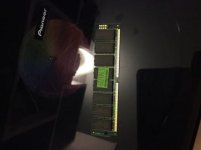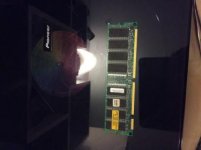Hi all,
so I've just bought a 586 PC of eBay, and having repaired the RTC I'm now trying to upgrade the RAM. It has 6 ram sockets, four fit this sort of RAM:

And two, this kind:

So there where four modules of the first kind installed, totalling 48MB. I removed these and installed two of the second kind which should total 128MB. Upon turning the system on, all the lights and fans come on and a rather loud continuous beep is played, coupled with no system activity. I've tried each of the larger modules separately too no avail, any ideas?
so I've just bought a 586 PC of eBay, and having repaired the RTC I'm now trying to upgrade the RAM. It has 6 ram sockets, four fit this sort of RAM:

And two, this kind:

So there where four modules of the first kind installed, totalling 48MB. I removed these and installed two of the second kind which should total 128MB. Upon turning the system on, all the lights and fans come on and a rather loud continuous beep is played, coupled with no system activity. I've tried each of the larger modules separately too no avail, any ideas?
